Mumbai: It was on this day in 2008 that Mumbai, India’s financial capital was held to ransom by a group of Pakistani terrorists who landed in the city via sea route.
Over 166 people, including foreign nationals, were killed in the attack that lasted for four days. The 26/11 attack, which transformed India’s outlook towards national security and led to strengthening its maritime surveillance and inter-agency coordination and dissemination of information, witnessed 10 Lashkar-e-Taiba terrorists going on a killing spree in the buzzing metropolis during peak hours.
How events unfolded on the night of November 26, 2008
The LeT terrorists landed in Mumbai via sea route, which originated from Karachi in Pakistan. On the night of November 23, 2008, the group hijacked an Indian fishing trawler MV Kuber. Pretending to be adrift, they boarded the trawler and as soon as the trawler sailed closer to Mumbai, they killed Amarchand Solanki, the captain of MV Kuber.
The group then launched their inflatable boat and landed in Mumbai at about 8.15 pm on November 26. Armed with grenades, AK-47 rifles, GPS set, eatables and mobile sets, the group then launched the first attack at Mumbai’s Chhatrapati Shivaji Terminus (CST). Ajmal Kasab, who was later held and hanged as the sole surviving terrorist of the attack, along with another terrorist Ismail Khan killed nearly 58 people at CST and injured over 100.
Their attempt to attack Cama Hospital was thwarted by the alert hospital staff members. However, the gunmen managed to kill six police officials including ATS chief Hemant Karkare, Vijay Salaskar and Ashok Kamte.
Kasab and Ismail took the same car that the three policemen were travelling in, and went on to continue with their killing spree. They abandoned the vehicle – MH 01 BA 569, a Toyota Qualis was abandoned after the police fired upon it and flatted its tyres.
It was on this day in 2008 that Baby Moshe, the Israeli toddler, who later became the face of survivors of the attack, became an orphan after his parents Rabbi Gavriel and Rivka were killed at Nariman House by the terrorists along with four other Israelis. Moshe, 2, was rescued by his nanny.
While Kasab and Ismail continued with the rampage on one side, another terrorist group carried out an attack at the Trident Hotel. Two terrorists entered the lobby of the opulent 800-suit hotel spraying bullets at the gatekeepers and staff members at the reception. The terrorists held several foreign tourists as hostages. By about 6 am on November 27, the NSG, after a bureaucratic delay, took over the operation. The siege ended on November 28 and 143 hostages were rescued alive while 24 bodies were recovered. Both the terrorists were killed by NSG commandos.
The historic dome of the iconic Taj Mahal hotel, engulfed in smoke became the most memorable image of the horrifying attack. Four heavily armed terrorists held the iconic building and its occupants hostage for almost 60 hours. Abdul Rehman Bada, Abu Ali, Shoib and Umer were neutralised by the security forces. Major Sandeep Unnikrishnan, an officer serving in the elite Special Action Group of the National Security Guards was martyred during the operation. The siege concluded on November 28.














